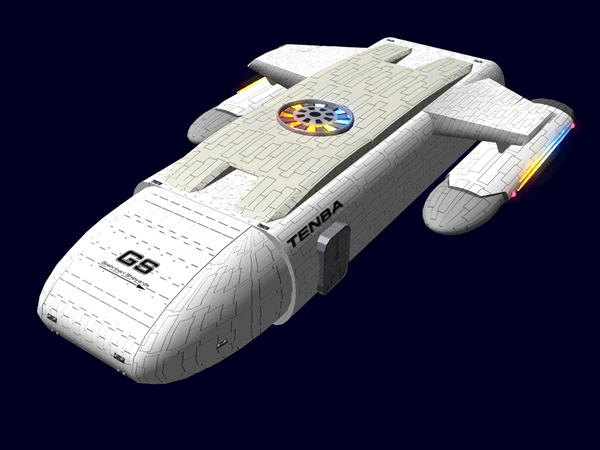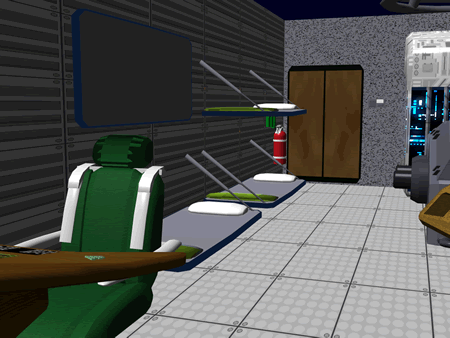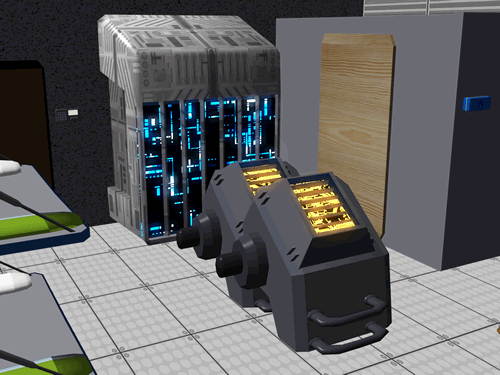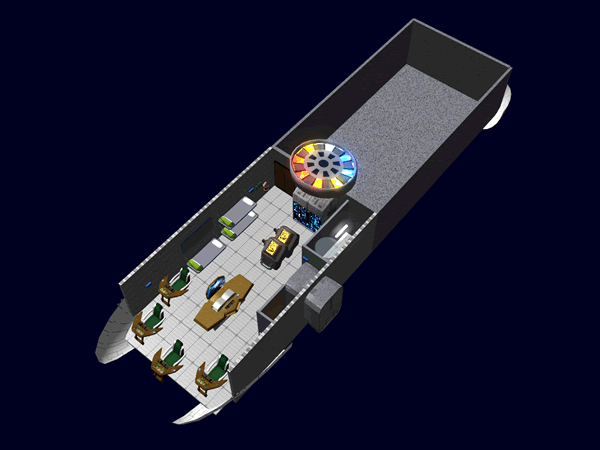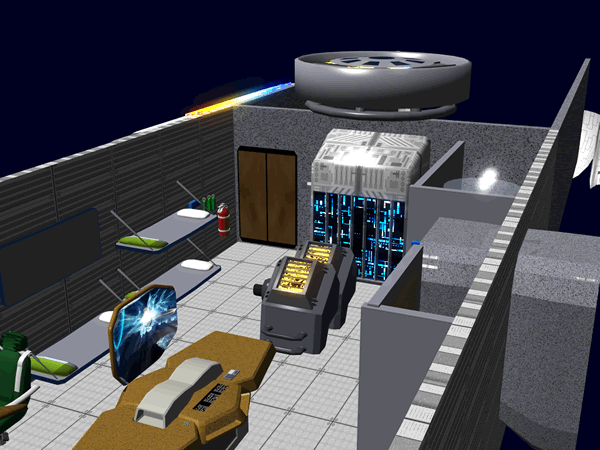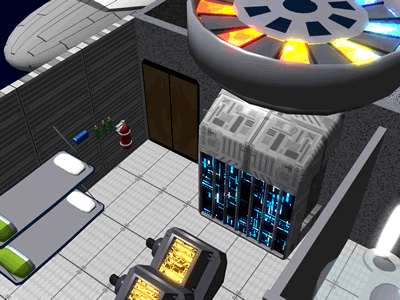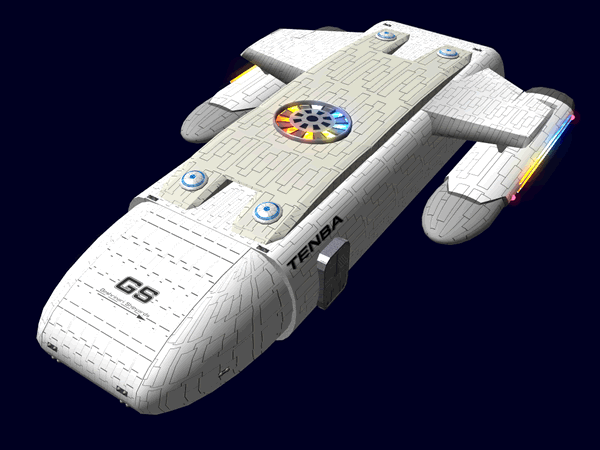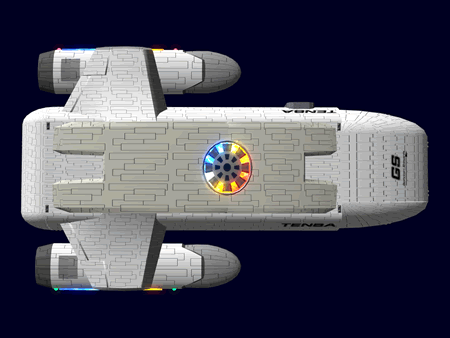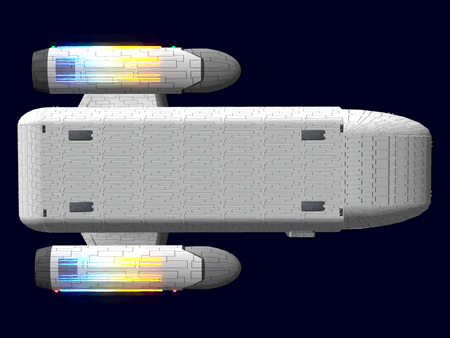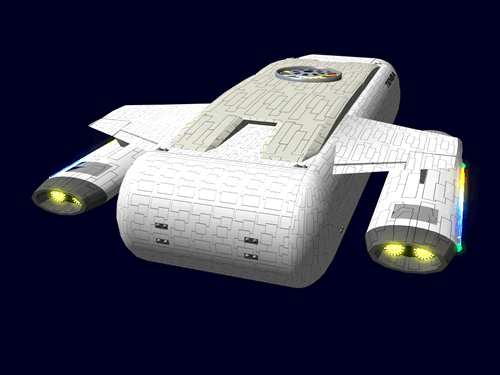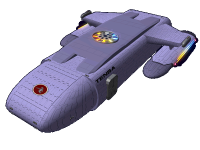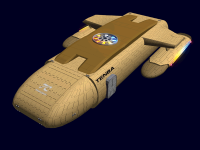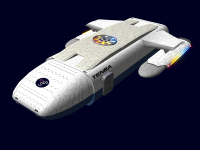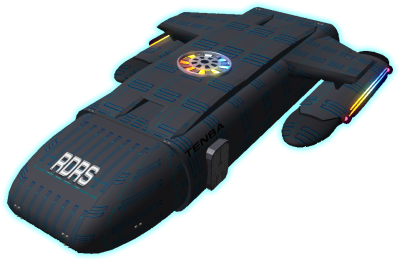Sidebar
Table of Contents
Ge-E1-1a - Tenba-Class Transporter
The Tenba-Class is a small workhorse spacecraft, larger than most shuttles and smaller than most starships. It became available in YE 34. The version of this ship re-designed for disaster recovery operations is the RDRS Ge-E1-1c - Tenba Class.
About the Tenba-Class
The Tenba-Class or the Pegasus-Class is the largest aerospace craft Geshrinari Shipyards manufactures. Units sold within the Empire are designated as Tenba while those sold outside are Pegasus. It features a mixture of systems designed to keep the cost down but make the craft as durable as possible.
The most important aspect of the Tenba is the mission configurable section. or MCS. The MCS dominates the rear of the craft. The MCS is 6 meters wide, 11 meters long, and 3.5 meters tall. They are loaded by opening the rear of the craft which swings up to let them be loaded.
During the design effort the Tamahagane Corporation realized that this craft would be a good addition to its space stations to ferry personnel and equipment within system or to neighboring ones.
History
The Tenba-class design was born in the days after Battle of Yamatai. Airlifting supplies and personnel to devastated areas required either more standard shuttles, or more trips. For this reason Tamahagane Corporation decided to design a new utility aerospace craft. The concept was to have a vehicle that could easily configured for different missions. The vehicle was constantly referred to as a workhorse during the design stage. Since it is a flying vehicle, it was named Tenba which means winged horse or Pegasus.
The simple design helped the project proceed and prototypes were soon being field tested in emergency aid response. These prototypes were limited to atmospheric travel, but served well and helped with enhancements in the final design.
Scientific Studies Service (SSS) personnel working in the emergency areas seeing the early prototypes contacted the corporation regarding acquiring some for their field use.
Appearance
The Tenba body is a flatten cylinder with a tapered front. Mounted on either side of the aft are the nacelles that house the plasma drives and the CDD. The CFS emitter is visible on the top of the ship in the center. On the bottom there are four landing skids that are visible. The appearance of the aft is a shorter more rounded aspect that the front of the vehicle. The top of the Tenba has an extension referred to as the over carriage. This is where items that would not easily fit inside were installed.
Statistical Data
General
Class: Tenba-Class Nomenclature: Ge-E1-1a Type: Utility Craft Designers: Tamahagane Corporation R&D Manufacturer: Geshrinari Shipyards Organizations using: Tamahagane Corporation, Scientific Studies Service (SSS) Price (MSRP): 40,000 KS
- M3402 - Cargo: 0 KS
- M3403 - Troop: 2,000 KS
- M3404 - EMS: 12,000 KS
- M3405 - Duration: 6,000 KS
- M3406 - Passnger: 5,000 KS
Crew and Accommodations
- Crew: 4 (Can be operated by a single person)
- Passengers: Depends on configuration
- Maximum Capacity: Depends on configuration
Dimensions
- Length: 25.0 meters ( feet)
- Width: 14.6 meters ( feet)
- Height: 4.5 meters ( feet)
- Decks: 1 (4 meters each)
Propulsion and Range
Speeds
The Tenba is nimble vessel.
- Atmospheric: 2,450.088 kph (1,522.414 mph) Mach 2
- Water: 100 kph (62.137 mph)
- Thrusters: 0 - 1 m/s²
- Sublight Engines: .375c (~112,422 kilometers per second) (~69,856 miles per second)
-
- Minimum: Resting motionless
- Cruising Speed: 8,000c (.92 ly/h)
- Maximum Speed: 10,000c (1.15 ly/h)
Durability and Maintenance
Service Lifespan: Estimated 20 years of constant use, possibly longer with refits.
Refit Cycle: Frequent minor updates through the Geshrinari Shipyards system and a refit once every four to five years.
Damage Capacity
See Damage Rating (Version 3) for an explanation of the damage system.
Hull: 20 SP (Armor) Shields: 25 (Threshold 5)
Inside the Tenba
The Tenba interior is by nature functional. Its amenities are spartan when compared to a starship. The forward section has 2.5 meters of of clearance floor to ceiling. It has variable lighting in three zones, forward, middle and rear of the main compartment.
Sensors
The Sensor array is mounted in the over carriage.
Flight Deck
The forward most point of the interior of the Tenba is the flight deck. It features four Geshrinari Standard Console setup as the following stations.
Pilot
The center console in the front of the section is the the pilot station. From here the operator flies the craft.
Navigation
The right front console is the navigation station. The operator here plots course and trajectories, they also control the primary sensors.
Systems
The left from console is the System monitoring station. From here the operator can monitor all of the crafts systems, and make adjustments as well.
Science
The furthest console on the starboard side is the Science Station. The operator can access the Tenba's standard sensors as well as the Life Science Sensor Package.
Airlock
The Tenba has an Geshrinari Airlock with a docking feature. Inside the craft next to the airlock is storage locker with EVA gear.
Crew Amenities
The Tenba is designed for long duration trips or missions, so it is equipped with a number of amenities for the crew's convenience.
Bunks
The craft is equipped with four bunks that fold out from the starboard wall. Each comes with 1 pillow, 1 sheet and 1 blanket. They are covered with a fitted sheet covered pad of acceleration foam for comfort. They extend or retract with a touch of a button located near the head of the bunk on the exterior. A safety net can be pulled out of the wall to attach to the edge of the bunk to keep the occupant contained during unexpected movements.
Hygiene
The Tenba has a one person bathroom with a sink, commode and a shower. Located aft of the airlock on the port side.
Engineering
Against the rear wall is the heart of the Tenba The unit houses the anti-matter generator and combined field system.
In front of the main unit are the two fusion generators which supply backup power.
Most of the other ship systems are built into the floors and walls of the craft.
Maintenance Conduits
The Tenba is too small for standard conduits. Access for repairs and maintenance to the vehicle systems is possible by removable floor panels. The panels are secured by quarter-turn fasteners that require positive sustained torque to unfasten. There are removal tools in stowed in a compartment in each section of the craft.
Center Passenger Area
The Tenba has all its amenities in one central location. A Geshrinari Work Table fills the center of the space. There are four padded stools that fit under the table and secure with latch hook panels.
Emergency Supplies
The Tenba has two open Emergency Supply Stations. One is located on the starboard side by the door to the rear section. The other station is located on the port side, just forward of the EVA locker. Each ESS has the following:
- 3 O2 Walkabout bottles
There are also four EM-G16-2a First Aid Kit located in each of the four quadrants of the interior.
Weapon placements
The Tenba is equipped with defensive weapons. They are retractable and mounted in the over carriage.
Ship Systems
Armored Hull
The Tenba is equipped with a GE-T1-H3300 - Spacecraft (DO) Hull Construction monocoque hull. The wings and engine brackets are made of GE-V1-H3302 - Spacecraft (OO) Hull Construction.
Computer and Sensor Systems
The Tenba uses a network of four Ge-T8-E3103 - Computer Arrays to handle all the computing needs. The arrays are networked by fiber optic cables and a located in four different locations for redundancy. Technically the Tenba can operate with only one, but performance would be impaired.
Because it is designed for long distance travel it is equipped with the Ge-Y2-E3301 - Standard Starship Sensors. The Tenba is also equipped with Ge-Y2-E3305 - Life Science Sensor Package
Emergency Systems
The Tenba is equipped with the Ge-Y1-E3104 - Automatic Fire Suppression System system and also has handheld extinguishers stored at key locations.
Life Support System
The Tenba is equipped with a pair of Ge-T8-V3100 - Environmental Systems to provide all life support requirements.
Power Systems
The Tenba is equipped with a dual power system.
Primary Power
The craft uses a Geshrinari Anti-Matter Generator as its primary power system. It is capable of powering all primary system. It carries enough fuel for the ship to run normally for thirty days without collecting more.
Secondary Power
The craft uses a pair of Geshrinari Fusion Generator for backup power. The generators can provide power ten days without collecting more.
Fuel System
The craft can refuel both types of fuel at a space port or it can use its integrated Geshrinari Matter Collection System.
Propulsion
FTL
The Tenba is equipped with Geshrinari Continuum Distortion Drive mounted into the nacelles for FTL travel.
STL
The Tenba is equipped with four Geshrinari Turbo Plasma Drive installed in the nacelles for STL travel.
Atmospheric
For added safety the Tenba has a Geshrinari Graviton Engine for launching and landing and low level atmospheric propulsion.
Thrusters
The Tenba has twenty Geshrinari Maneuvering Thrusters for attitude and maneuvering control.
Shields
The Tenba is equipped with a Geshrinari Combined Field System, the primary emitter is located on the top of the over carriage.
Weapons Systems
The Tenba is equipped with four retracting Ge-E1-W3400 - Dual Plasma Arrays.
Tether
The Tenba is equipped with a dorsally mounted Geshrinari Graviton Beam Projector. It was added so that the craft could airlift objects too large to fit within.
Landing Skids
The Tenba is fitted with four landing skids. The skids extend twelve inches prior to touching down automatically. They retract when taking off as well. A laser range finder controls the skids; passing thirty feet either extends them or retracts them. There is a manual override control as well.
Mission Configurable Section
These are the standard Mission Configurable Sections currently available for the Tenba. There is a two step drop into the MCS. They have standard atmosphere and environmental conditions. Additional standard modules may be developed and custom ones available on request.
To switch modules, the back end of the Tenba swings up and the module is rolled in or out. Once in the module as it settles connects to the infrastructure of the Tenba.
Non-technical data
Standard Equipment
- 6 O2 Walkabout bottles (30 minute supply)
- 24 Emrys Quik Paks typically preselected
- 2 boxes of Emrys Emergency Rations
EVA Locker
- 2 Entrenching Tool, folding
- 3 50 meters of high-strength cord
Color Schemes
Disaster Recovery Version
The redesigned Disaster Recovery version of this ship is the RDRS Ge-E1-1c - Tenba Class, pictured below.
This Rapid Disaster Response Service shuttle was meant to quickly ferry small groups across space during disaster recovery operations. This shuttle might move specialized disaster recovery technicians, needed medical personnel, or leadership teams from different locations in space.
OOC Notes
Authored and artwork by Nashoba Feb 02, 2012
Submission Approved by Kyle on Feb 06, 2012. Forum Thread.
| Products & Items Database | |
|---|---|
| Product Categories | small craft |
| Product Name | Tenba-Class Transporter |
| Nomenclature | Ge-E1-1A |
| Manufacturer | Geshrinari Shipyards |
| Year Released | YE 34 |
| Price (KS) | 40 ,000.00 KS |
Page Tools
Terms of Service - Privacy Policy

